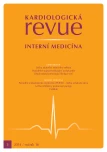Acute heart failure treatment
Authors:
J. Špinar 1; J. Pařenica 1; L. Špinarová 2; J. Vítovec 2
Authors‘ workplace:
Interní kardiologická klinika LF MU a FN Brno
1; I. interní kardioangiologická klinika LF MU a FN u sv. Anny v Brně
2
Published in:
Kardiol Rev Int Med 2014, 16(3): 171-177
Category:
Cardiology Review
Overview
Treatment of acute heart failure remains complicated and in-hospital mortality remains high at 10%. Diuretics are still the drug of first choice, mainly loop diuretics. It is important to treat complications like infections, diabetes mellitus, etc. Other treatments can be divided into vasodilators and positive inotropic drugs. Vasodilators are especially suitable for patients with BPs > 100 mmHg or even > 115 mmHg, and the drugs of choice include nitrates and nitroprusside. Nesiritide has not shown a decrease in mortality, while ularitide and serelaxin are being tested. Dopamine, dobutamine and phosphodiesterase 5 inhibitors are representatives of positive inotropic drugs, but none of them has clear mortality data. Promising data were shown with omecamtiv mecarbil, but the first mortality trial, ATOMIC, showed neutral results. Levosimendan is the only calcium sensitizer with a large clinical program and with neutral and slightly positive results. Repetitive use of levosimendan is also recommended. Antiaggregation, anticoagulation, analgesics and sedatives are also part of acute heart failure treatment, as well as oxygen and non-pharmacological methods.
Keywords:
acute heart failure – diuretics – vasodilators – inotropes – levosimendan
Sources
1. McMurray JJ, Adamopoulos S, Anker SD et al. ESC Guidelines for the diagnosis and treatment of acute and chronic heart failure 2012. The Task Force for the Diagnosis and Treatment of Acute and Chronic Heart Failure 2012 of the European Society of Cardiology. Developed in collaboration with the Heart Failure Association (HFA) of the ESC. Eur Heart J 2012; 33: 1787– 1847. doi: 10.1093/ eurheartj/ ehs104.
2. Nieminen MS, Boehm M, Cowie MR et al. Executive summary of the guidelines on the diagnosis and treatment of acute heart failure: the Task Force on Acute Heart Failure of the European Society of Cardiology. Eur Heart J 2005; 26: 383– 416.
3. Špinar J, Janský P, Kettner J et al. Doporučení pro diagnostiku a léčbu akutního srdečního selhání. Cor et Vasa 2006; 48: K3– K31.
4. Špinar J, Vítovec J, Hradec J. Co je nového v evropských doporučeních pro diagnostiku a léčbu srdečního selhání. Kardiol Rev 2012; 14: 211– 212.
5. Zamora E, Lupón J, Vila J et al. Estimated glomerular filtration rate and prognosis in heart failure: Value of the Modification of Diet in Renal Disease study‑ 4, Chronic Kidney Disease Epidemiology Collaboration, and Cockroft‑ Gault formulas. J Am Coll Cardiol 2012; 59: 1709– 1715. doi: 10.1016/ j.jacc.2011.11.066.
6. Spinar J, Parenica J, Vitovec J et al. Baseline characteristics and hospital mortality in the Acute Heart Failure Database (AHEAD) Main registry. Crit Care 2011; 15: R291. doi: 10.1186/ cc10584.
7. Špinar J, Vítovec J, Hradec J et al. Doporučení pro diagnostiku a léčbu chronického srdečního selhání – ČKS 2011. Cor Vasa 2012; 54: 161– 182
8. Moiseyev VS, Põder P, Andrejevs N et al. RUSSLAN Study Investigators. Safety and efficacy of a novel calcium sensitizer, levosimendan, in patients with left ventricular failure due to an acute myocardial infarction. A randomized, placebo‑ controlled, double‑blind study (RUSSLAN). Eur Heart J 2002; 23: 1422– 1432.
9. Mebazaa A, Nieminen MS, Packer M et al. Levosimendan vs dobutamine for patients with acute decompensated heart failure: the SURVIVE Randomized Trial. JAMA 2007; 297: 1883– 1891.
Labels
Paediatric cardiology Internal medicine Cardiac surgery CardiologyArticle was published in
Cardiology Review

2014 Issue 3
Most read in this issue
- Diverticular disease of the colon – new trends in therapy
- Irritable bowel syndrome – diagnosis and treatment
- Chronic pancreatitis
- Proton pump inhibitor treatment
